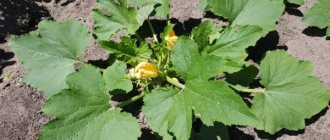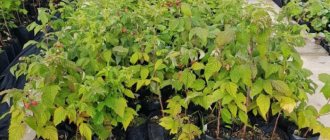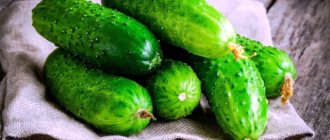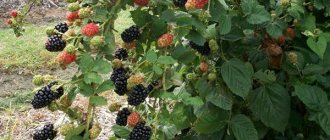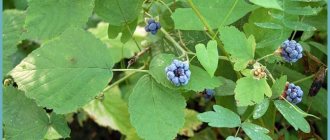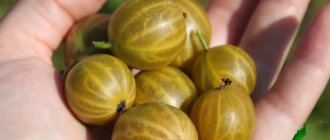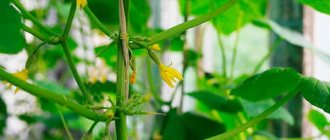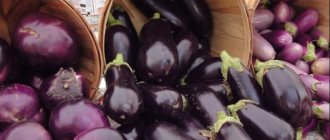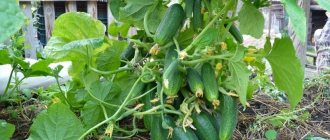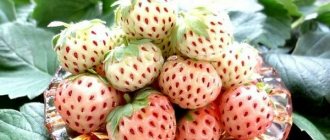The most delicious varieties
The sweetest ones include:
- Arapaho . Refers to thornless, upright growing shrubs. The medium-sized fruits growing on the side branches have a pronounced taste and aroma. Frost-resistant, can be left without insulation.
- Osage is an upright, thornless shrub. Very tasty, does not spoil for a long time.
The following also have excellent taste: Prime Yang, Navajo, Thornfree, Karaka Black, Flint.
Features of reproduction
Reproduction of a plant is an important step in its further cultivation. There are several ways to propagate thornless blackberries. The most difficult and time-consuming method is propagation using seeds. Only experienced gardeners undertake it.
Dropping method
In August, you need to select a strong one-year-old shoot and dig it onto one bayonet of a shovel. You can make an iron clip to secure the branch. The tip of the shoot is cut by 10 centimeters so that it does not grow, and left in the air. The digging area must be mulched and watered periodically.
After 2 months, the new plant will take root. Separation of the seedling from the bush should be done in early spring. It must be transplanted from the mother plant at a distance of at least 2 meters.
Root shoots
From a bush that is already more than 3 years old, you can separate the root shoots. They begin to appear only after 2 years of life. The shoots must be carefully separated from the bush with a sharp shovel and transferred to the planting site. If everything is done correctly, young plants will not get sick.
This method is best implemented in the spring, when stable warmth sets in.
Cuttings
The most acceptable and frequently used method of propagation is cuttings. Chopped shoots containing 3-5 live buds are suitable for these purposes. Each eye produces a full-fledged seedling, so the method is also considered rational.
The correct reproduction algorithm will help achieve the expected result:
- The cutting must be tilted upside down so that the bud touches the water. The glass is placed in a warm, well-lit place. Water must be constantly added so that the kidney does not remain without moisture.
- After some time, white roots will appear from the eye.
- Part of the cutting with a sprouted bud must be cut off and planted, covering the roots, in a nutrient substrate.
Do this with all the eyes on the cut shoot. From one cutting you get from 4 to 8 independent plants. Each of them must be grown in a glass until it gets stronger.
It is important to know that despite the unpretentiousness of blackberries, they must be cared for carefully in order to get the expected result. Varieties must be selected depending on climatic and weather conditions. Yield is not always the main indicator. In some cases, transportability or taste are a priority. It is also important to realize that frost resistance remains an important factor when planting in northern regions.
thornless blackberry
Wild bushes are thorny jungles. It is for this reason that many summer residents have no desire to breed them. However, thanks to the work of breeders, varieties without thorns were developed. They are preferred by many gardeners, since the collection process does not cause any inconvenience. Characterized by a well-developed root system. They can survive without moisture for a long time.
The most commonly used types in this category are:
- Thornfree. It is the first thornless hybrid to come to Russia from America. Belongs to the genus dewberry with large fruits. When unpruned, it grows up to 5 m in length. The berries are sweet, large, aromatic. Weight can reach 6-7 g, length - up to 4 cm. During the ripening process they become soft, so their shelf life is short. In the conditions of the Moscow region, mandatory insulation is required during the cold season.
- Black Satin. Obtained by crossing different varieties. As it grows, it first appears erect and then droops. If not pruned, it grows up to 4.5-5 m in height. The berries are sweet and sour, weighing up to 8 g. It is afraid of frost, so winter shelter is required.
- Apache. It is a variant with an average ripening period (July). The fruits are black, sweet, weighing up to 10 g. They are frost-resistant and have a low degree of susceptibility to disease.
Trimming
The fruits of thornless blackberries, like raspberries, are formed on side branches of last year's shoots. During the season, the plant forms replacement shoots, which will bear fruit only next summer. Blackberry bushes need supports, which are poles with wire stretched between them.
The distance between adjacent pillars is 3 m. The wire is pulled in 4–5 rows, leaving 30 cm between them. The first row is raised above ground level by 45 cm.
Blackberry shoots are fixed between rows of wire
When pruning blackberries, gardeners recommend adhering to the following rules:
- Sanitary pruning of bushes is carried out in the spring. Even before the buds swell, dry branches that have not weathered the winter well are removed. The frozen tops of the shoots are cut off to a living bud. Pruning for preventive purposes is carried out for all plants on the site - both young and adult plants.
- Pruning of bushes in the first year of life is carried out twice: in spring (in May) and in summer (in July). Spring pruning is carried out on new side shoots in order to stimulate their growth. The branches are shortened by 5–7 cm. Summer pruning is designed to shorten shoots whose length exceeds 0.5 m. The branches are pruned by 7–10 cm. Pinched tops allow the branches to develop in thickness, which has a beneficial effect on the number of flowers and the future harvest as a whole. On young bushes, in the summer, all newly formed branches on the sides are eliminated, leaving only 6–8 of the largest ones.
Blackberries are pruned twice per season: in spring and mid-summer.
- For bushes that are more than 2 years old, all dead branches are removed in the spring, keeping 4–10 strong ones. The shoots are trimmed from the sides by 20–40 cm, providing for the presence of 8 to 10 live buds on them. During the summer season, all newly emerging shoots are picked from the roots. Only spring ones are preserved, which will become fruitful next year. The branches of the current season are shortened to a length of 1.6–2 m. If the number of branches of the current year is small, healthy shoots are left, shortening the lateral ones by 2 cm. Fruit-bearing bushes are cleared of branches weakened and affected by pests and diseases. They are replaced by young shoots.
Video: how to properly prune blackberries
Frost-resistant options
Winter-hardy varieties are best suited for the Moscow region, where frosts are not uncommon even in the warm season:
- Agawam. It is resistant to low temperatures (down to -40 °C), which is why shelter for the winter is not necessary. There are small thorns on the branches. Does not require special care, feels good even in abandoned areas. Capable of producing up to 5 kg of harvest. It has a pleasant aroma, a sour taste, and weighs from 5 to 10 g.
- Gazda. A large shrub covered with small thorns. Reaches maximum maturity by early autumn. Fruit weight is up to 7 g. After assembly, they retain their original properties for a long time and tolerate transportation well.
- Darrow. Resistant to low temperatures (down to -35 oC). The trunk is covered with long spines and reaches a height of 3 m. The weight of the berries is up to 4 g. In 12 months you can harvest about 10 kg of crop, and this figure increases every year.
- Polar. Thornless and straight-growing variety up to 2.5 m high. Resistant to frost, pests and diseases. The weight of the fruit can reach 11 g. They have a pleasant aroma and sweet and sour taste.
Blackberries: productive varieties for the Moscow region
Blackberry varieties grown in the Moscow region are perfectly adapted to the climatic conditions of the middle zone.
Experienced gardeners, when choosing seedlings for growing in dachas and garden plots, pay attention to resistance to low temperatures and fruitfulness and purchase the most winter-hardy and productive varieties. Blackberries are sometimes called black raspberries due to the external similarity of these species. In the berry bush family they are considered the closest relatives. Despite the fact that blackberries are less tolerant of frost than raspberries, they are invariably in demand and popular due to their exceptional yield.
Unpretentious and productive
Agawam is considered one of the most unpretentious. It takes root quickly after transplantation and can bear fruit for up to 10 years.
They also feel good in the Moscow region:
- Ufa local. Not afraid of pests and not susceptible to diseases. Resistant to cold weather. The berries are fragrant, tasty, weighing about 3 g.
- Flint. Originally from America. Withstands temperatures down to -40 oC. Average weight is from 5 to 7 g. One bush brings up to 10 kg.
Blackberry varieties for the Moscow region - rating of amateur gardeners
Adding an article to a new collection
Reduces blood pressure, activates thinking processes, strengthens the heart and blood vessels, improves metabolism and improves immunity, and is widely used for medical purposes. This is not to mention the excellent taste and rich set of vitamins and microelements.
And this is all about blackberries, which many gardeners undeservedly “bypass”, for various reasons preferring to grow more familiar crops on their plot. But in vain!
Maybe you should reconsider your views and try to plant this plant in your dacha? After all, planting and farming blackberries is not particularly difficult. Moreover, selection does not stand still and for the conditions of middle latitude, “convenient” varieties of this berry have long been bred for every taste - productive, winter-hardy, large-fruited, sweet, unpretentious, remontant, early ripening, thornless...
Here is a small list of the best varieties of blackberries for the Moscow region with photos and descriptions.
Repairable species
A key feature of the remontant variety is the possibility of double harvesting. The first ripens by the beginning of summer from old shoots, the second - closer to autumn on new bushes.
If the shoots are cut to the roots in the fall, you should expect only one fruiting next year.
The most popular varieties include:
- Ruben. The height reaches 2 m. The berries are large, weighing up to 14 g. Does not require tying. Unpretentious, resistant to frost and disease.
- Black Magic. It is not resistant to low temperatures, which is why the bushes are either bent or cut off during cold weather. Gives a rich harvest.
- Prime Ark-45. Up to 2 m high, shoots are covered with needles. Blackberries are oblong, large, and have a sweet taste. The first wave arrives already at the beginning of summer. The second wave occurs at the beginning of autumn and continues until severe frosts.
- Prime Jim. It has strong shoots covered with large thorns. The fruits are oblong in shape. They have a pleasant sweet and sour taste.
- Prime Yang. Upright version of medium height. Ripens earlier than other remontant species. It has a pleasant aroma of apples and a pronounced sweet taste.
- Prime Arc Freedom. It has a pleasant taste and strong aroma, and tolerates transportation and storage well. Requires shelter for the winter.
Good to know: How to grow blackberries in the garden
Blackberries without thorns - the best varieties for the Moscow region
Raspberries and strawberries are traditional berry bushes that are found in every garden near Moscow. But blackberries are not inferior to them in popularity. This juicy berry is rich in vitamins and has a rich taste. Unlike wild strawberries, which can often be found in the forests of the Moscow region, we offer you the best cultivated varieties of blackberries, which amaze with both their size and delicious taste. And the most important thing, perhaps, is that the cultivated varieties of this crop do not have thorns, which makes it easy to harvest and enjoy the delicious berries.
Thornless blackberries are a pleasure to harvest
Shrub care
The plant, although unpretentious in care, still needs certain measures. It is recommended to water a first-year seedling 2 times a week. More mature specimens are moistened as needed, i.e. when there is no rainfall for a long time, as well as during the period of fruit formation.
You need to loosen and remove weeds regularly, ideally after each watering. The use of mulch can make such work easier.
The shoots can easily do without additional feeding. However, if you want to increase their productivity, organic fertilizers will be required. Both compost and humus are suitable (5 kg per 1 sq.m. of soil). During the ripening period, it is better to use potassium fertilizer.
The main pruning should be done in the autumn, after harvesting. 6-8 strong new shoots, shortened by 1/3, are left. Everything else is cut out. In spring, only broken or unhealthy branches need to be removed. By trimming the top, plant growth is activated.
In winter, blackberries need to be covered to protect them from the cold. The plant bends down to the ground and is insulated with covering material or mulched.
How to plant and grow blackberries in the Moscow region
Blackberries are lovers of light, but even in dark places in the countryside they can please gardeners with good harvests. But without access to the sun, the harvest will be minimal, and the fruits will grow small. Growing does not require much effort, and with minimal care the plant will delight you with a good harvest.
Preparatory work
The pit for planting seedlings must be prepared at least three weeks in advance. The best option is to prepare a place in the fall and add manure to the hole.
The plant is purchased with a strong root system and without damage.
Required soil composition
You will need fertile and loose soil made from rotted plant residues.
Timing and proper planting in the ground
Any novice summer resident does not know when to plant a plant correctly, so that it takes root and pleases with the harvest faster. Therefore, before purchasing, study important points:
- Plant seedlings immediately after the soil thaws.
- If the bush has long lashes, then place the plant in a row every 2 meters. For erect ones you will need a distance of 1 meter.
- Between the rows they maintain 2.5 meters.
The site is chosen to be sunny and protected from the wind. The ideal place is the edge of an apple orchard. Groundwater should be below 1.5 meters.
Key points of bush care
Agricultural technology is an important condition for obtaining a bountiful harvest. Although the plant is unpretentious, it requires special attention. Blackberries require constant inspection. If pests are detected, destroy insects mechanically or chemically. At the first signs of disease, treat with special preparations.
Watering
The crop easily tolerates drought, but prefers moist soil. Regular watering will help achieve a good harvest.
Loosening the soil
To make the plant feel better, the soil is saturated with oxygen by loosening. Then mulch the soil to retain moisture. This increases fruiting.
Top dressing
If the plant has slowed down or there is a reduction in yield, then apply 20 grams of nitrogen fertilizer to each bush.
Blackberry pruning
The plant needs regular pruning. Conducted twice a season.
in spring
Shoots that did not survive the winter are removed. Then, to improve fruiting, the tops of healthy branches are cut off.
in autumn
There are two types:
- In a remontant variety, shoots are removed at the root. This is aimed at obtaining a late harvest.
- Remove fruit-bearing biennial shoots and excess growth from the usual variety at the root. Leave only strong stems and cut them by a quarter.
How to tie blackberries
Upright plants are tied with a cloth to the bottom row of the trellis and allowed to grow horizontally. This will make it easier to cover the bushes for the winter in the future.
Blackberry shelter for the winter
To protect the plant from frost, the bushes are bent to the ground and covered with covering material. Also, to protect against cold weather, the soil is mulched.
Basic mistakes when growing
Since blackberries are heat-loving plants, they should not be watered with ice water (well or tap water). It is better to use one that has been heated during the day in a container or collected after rain.
You should not leave a ripening shrub without shelter. This may cause burns. You can preserve the appearance and quality by using a mesh stretched over the shoots, creating a protective shadow.
You should try to avoid forcibly bending the stems to protect them from frost. This can damage the branches and the bush as a whole. In order for the shoots to bend down on their own, it is recommended to hang weights on the tops of their heads a month before insulation. After this, all that remains is to carefully cover the bushes.
Following simple care rules and avoiding the mentioned mistakes will be the key to obtaining a rich harvest.
The best varieties of blackberries without thorns for the Moscow region
Until recently, the representative of this crop in Russia was mainly the Agavam variety. Despite its unpretentiousness and winter hardiness, it had a significant drawback - thorns, which make harvesting difficult. Due to the persistent belief that all varieties of blackberries are prickly, many Russian gardeners denied themselves the pleasure of seeing this shrub in their garden.
Especially for you, dear summer residents and gardeners, we have compiled a selection of the best hybrid blackberry varieties that have absolutely no thorns. All of them are distinguished by high fertility and amazing taste.
So, at the head of the popular varieties of thornless blackberries:
- "Black Satin". The unusually large, rich black, tasty and healthy berries of this variety are worthy of your attention. The crop multiplies very quickly, requires frequent pruning of the vines, and for convenience, a trellis garter is used. The reduced winter hardiness of the variety requires shelter for the winter.
- "Thornfree." The name itself, translated from English, speaks for itself - “without thorns.” This is an industrial variety with a high yield coefficient - up to 30 kilograms of berries per bush. It does not like shade and gives its owners fragrant berries with a dessert taste.
- "Evergreen Thornless" Sweet large berries of a light black hue will please everyone. The shrub has erect shoots, which makes harvesting easier, but makes it difficult to cover for the winter. In addition to the benefits of fruiting, it is also used for decorative purposes - to decorate arbors, arches and create hedges.
- "Smutstem." This variety is also ideal for industrial plantings, as it produces a rich harvest and is rarely susceptible to disease. Smutstem has fragrant black berries, with a high content of sucrose in the pulp. They ripen early and are easily transported in small boxes.
- "Natchez" An early variety of long-term fruiting - for over 5 weeks, this shrub will pamper you with large blue-black fruits that taste like cherries. The peculiarity of this variety is that the berries do not fall off the bush, do not rot, and are suitable for long-term transportation.
Advantages and disadvantages of remontant varieties
To make the right choice, it is recommended to take into account the advantages of this type:
- Unlike ordinary ones, new specimens are more adapted to the climate of the Moscow region. Considering that the shoots are brittle, tough, and do not withstand frost well, the bush is pruned at the root. This simplifies the covering process and significantly reduces the risk of the plant freezing.
- In spring and summer, the branches are decorated with large snow-white flowers that attract pollinators. This is useful for neighboring plants on the site.
- The remontant shrub is easy to care for and convenient to harvest. The shoots grow upward, the bush does not spread across the area.
- The maximum height of the perennial is 2 m. Plants can be grown in tubs and transferred to greenhouses for the winter. In this way, the fruiting period is extended for some more time.
- The blackberry bush is usually covered with sharp thorns, which make the plant difficult to care for. Breeders have developed thornless varieties that greatly simplify the work with shrubs.
Flowering blackberry bushes
- The fruits are firmly attached to the stems and are less susceptible to putrefactive processes. Remontant species are more resistant to disease than ordinary ones. Preventive treatments will not hurt the bush, since aphids on currants, blackberries, and gooseberries are a typical phenomenon.
The harvest can be harvested already in the first year of planting. If the seedling was sent into the ground in the spring, the berries will ripen by August.
Flaws:
- Blackberry bushes are sensitive to the slightest drought. They need to be watered frequently in the summer heat. A bountiful harvest ripens only if the soil is kept slightly moist.
- Alkaline soils are not suitable for growing.
- Under the weight of the fruit, the stems may bend towards the ground. This way the berries get dirty and the risk of rotting increases. To grow most varieties, trellises are required to maintain the shape of the bush and ensure proper ventilation of the crown.
- Like other types of blackberries, remontant berries are difficult to separate from the receptacle.
- To harvest from bushes with thorns, you will need thick gloves.
Ripe berries

